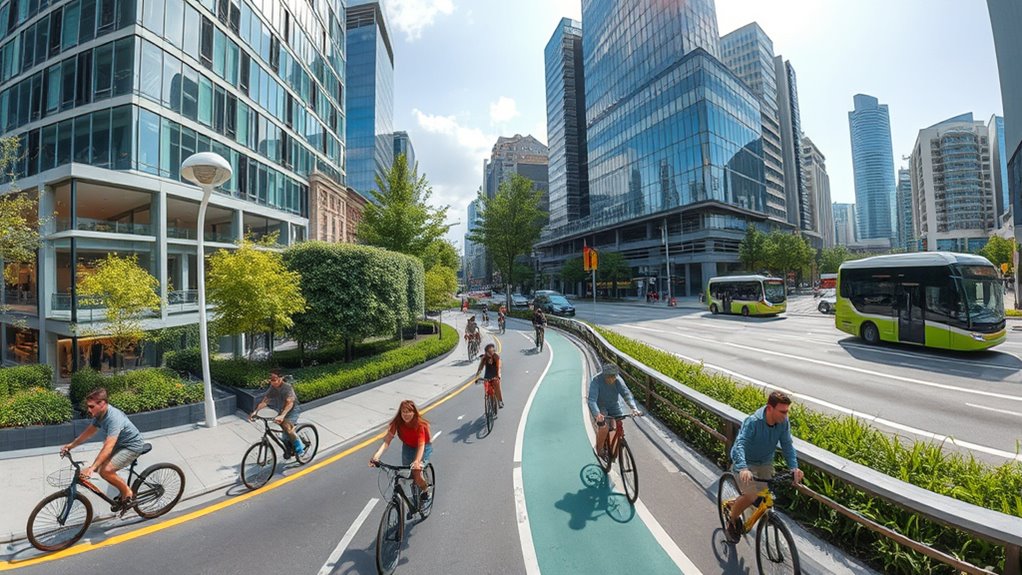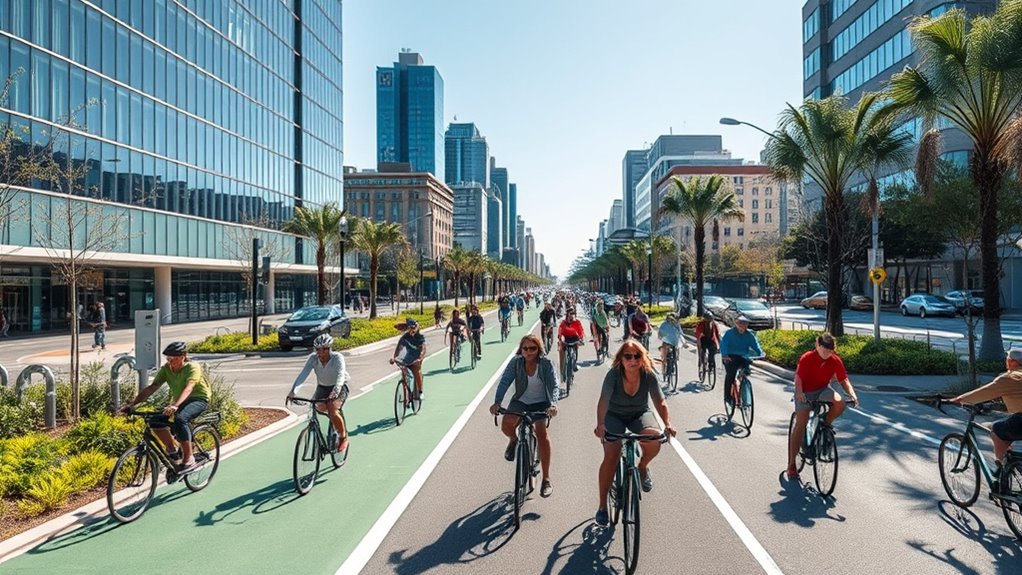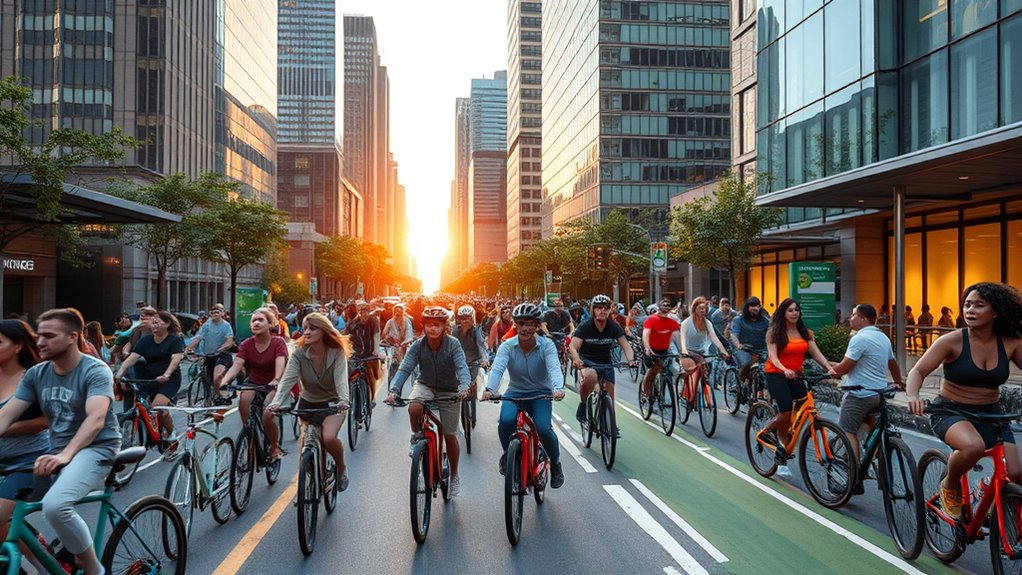The global shift toward cycling is gaining momentum, with the market expected to grow from over $77 billion in 2024 to more than $135 billion by 2030. Cities are investing heavily in bike infrastructure, promoting e-bikes and smart technology, while policies support sustainable urban mobility. Consumer preferences are changing, driven by health, environmental concerns, and technological advancements. Staying informed will help you understand how this transformation continues to shape the future of transportation.
Key Takeaways
- The global bicycle market is expected to reach over $135 billion by 2030, driven by urbanization and health trends.
- Increased investments in cycling infrastructure and policies will facilitate a significant shift from car use to cycling worldwide.
- Technological innovations like smarter e-bikes and longer-lasting batteries will enhance urban mobility and cycling convenience.
- Governments’ focus on sustainable transport will promote cycling through incentives, regulations, and integrated urban planning strategies.
- Growing cultural emphasis on sustainability and active lifestyles will boost cycling adoption across diverse demographics globally.
Market Expansion and Valuation Trends

The global bicycle market is experiencing robust growth, driven by rising urbanization, health awareness, and environmental concerns. In 2024, the market’s value hits around $77 billion, with projections reaching $84.25 billion in 2025.
Between 2025 and 2030, it’s expected to grow at nearly 10% annually, hitting about $135 billion. Alternative estimates suggest a $96.1 billion market in 2025, climbing to nearly $294 billion by 2037.
The bicycle market is projected to grow nearly 10% annually, reaching $135 billion by 2030.
The premium segment, valued at $12.3 billion in 2025, is also expanding steadily.
Asia-Pacific leads with over a third of the market, thanks to China, India, and Japan’s urban growth. Demand from urban congestion, government investments, and health trends fuels this expansion, ensuring the market’s continuous upward trajectory.
The Rise of Electric Bicycles and Smart Technologies

Advancements in electric bicycle technology are revolutionizing urban mobility by making e-bikes more powerful, efficient, and user-friendly. You’ll notice lighter, longer-lasting batteries like solid-state and lithium-ion, which provide greater range and faster charging.
Improved motors deliver reliable power for varied terrains, while smart connectivity lets you control your bike via apps, receive over-air updates, and track your rides.
Enhanced safety features, such as anti-lock brakes and digital anti-theft systems, increase security and confidence.
Modern e-bikes also feature lighter, foldable designs for versatility. These innovations make e-bikes more practical and appealing, encouraging wider adoption.
As technology continues to evolve, you can expect even longer ranges, smarter features, and seamless integration into your daily commute, transforming urban transportation. Additionally, the integration of advanced motor technology enhances overall performance and responsiveness, making e-bikes more efficient and enjoyable to ride.
Sustainability Initiatives and Urban Mobility Transformation

Sustainable initiatives are transforming urban mobility by prioritizing active transportation modes like cycling and walking. You’ll see policies that embed cycling infrastructure into long-term transport plans and urban design standards, aligning with climate, safety, health, and equity goals.
Governments are directing international climate funds and allocating at least 20% of transport budgets to develop protected, citywide cycling networks and neighborhood corridors, making bike travel seamless and safe. These efforts substantially cut transport emissions by shifting short trips from cars to bicycles, improving air quality and reducing congestion. Incorporating cycling infrastructure into urban planning ensures these benefits are sustainable and long-lasting.
Such initiatives also promote societal equity by expanding affordable cycling options, enhancing accessibility, and addressing transport poverty. Cities are adopting innovative infrastructure designs that incorporate smart technology and modular elements, further supporting the long-term success of these projects. This integration of sustainable materials into infrastructure not only enhances durability but also reduces environmental impact. Moreover, urban planning strategies are increasingly emphasizing mixed-use developments to foster more walkable and bike-friendly communities. International campaigns and knowledge sharing further accelerate this transformation, fostering best practices and innovative infrastructure designs across cities worldwide. Additionally, leveraging advanced construction techniques can optimize resource use and minimize environmental footprints in infrastructure development.
Regional Investment Strategies and Market Penetration

Regional investment strategies play a pivotal role in expanding cycling markets by leveraging diverse funding sources and aligning with broader urban goals. Cities like Abidjan and Recife demonstrate high returns, with EIRRs of 123.5% and 91.5%, showing the strong economic case for investment. Local governments creatively fund infrastructure through parking revenues, congestion charges, and developer contributions, enabling rapid, low-cost implementations. These investments often align with urban priorities like climate action, safety, and health. Cities such as Fortaleza have experienced significant growth, with cycling network expansion boosting adoption rates. Prioritizing at least 20% of transportation budgets for cycling infrastructure ensures sustainable growth. Regional cooperation, international funding, and adopting global best practices further enhance market penetration, making cycling a crucial component of modern urban mobility strategies. Incorporating renewable energy solutions into urban planning can further support sustainable transportation initiatives.
Evolving Consumer Preferences and Lifestyle Shifts

As health consciousness continues to rise globally, more people see cycling as an effective way to improve fitness, reduce obesity, and stay active. Major events like the Tour de France boost participation, while app-based bike-sharing systems make urban cycling more accessible. The affordability of e-bikes broadens participation across income groups, especially as post-pandemic habits remain focused on health. However, high ownership costs, especially for e-bikes, lead many to prefer rental or second-hand options. Governments encouraging e-bike incentives further influence choices. Digital tools such as GPS rentals and navigation apps enhance the cycling experience, making it more engaging. Cultural shifts, like sustainability and work-from-home routines, support leisure cycling, bikepacking, and multimodal travel, reflecting evolving consumer preferences that favor active, eco-friendly lifestyles. Additionally, headphones are increasingly used by cyclists to enjoy music or navigation cues safely while on the move. The rise of active transportation aligns with urban planning trends that prioritize sustainable mobility options over car dependency. Moreover, advances in drivetrain technology, such as shifting systems that allow smoother gear changes, contribute to more comfortable and efficient cycling experiences. Furthermore, innovative home decor solutions like wall organization systems can inspire cyclists to create dedicated spaces for their gear and accessories, enhancing their overall cycling environment.
Infrastructure Development and Cycling Tourism Growth

Growing consumer interest in cycling is prompting cities and governments to invest more in infrastructure. Federal funding for biking projects increased from 1.8% to 2.1%, signaling active mobility’s rising priority. However, gaps remain; Colorado needs $473 million annually for biking infrastructure, and Washington State faced a $1.6 billion backlog as early as 2008.
Protected bike lanes are spreading, with 31 states providing guidance, and training programs boost technical skills for implementation. Cities like San Francisco and Glasgow expand networks, attracting recreational and tourism cyclists.
High PNB rates in Irvine and regional connectivity efforts in Colorado demonstrate infrastructure’s role in boosting cycling tourism. Weatherproof, well-marked, and safe routes encourage sustained participation, supporting economic growth and the broader shift toward cycling.
Impact of Policy and Community Engagement on Cycling Adoption

Policy initiatives play a crucial role in shaping cycling adoption by creating a supportive environment and incentivizing behavior change. When governments invest in cycling infrastructure, you benefit from safer routes, which encourages more people to ride.
Incentive programs, like e-bike subsidies, especially help low-income residents get on bikes, reducing barriers. These policies also cut carbon emissions and air pollution by shifting transportation away from cars.
Promoting cycling through regulations and infrastructure support makes it easier for you to choose biking over driving. Community engagement amplifies these efforts—public health campaigns, local events, and partnerships foster a cycling culture.
When communities are involved in planning, you’re more likely to feel connected and motivated to cycle regularly, making sustainable mobility a shared goal. Additionally, vertical storage solutions can optimize space for bicycle storage, making it more convenient for you to keep your bike accessible and secure. Incorporating tableware into community events can also enhance the social experience and encourage participation. Furthermore, understanding the health benefits of cycling, such as improved cardiovascular health and mental well-being, can motivate more individuals to adopt cycling as a regular activity. Recognizing the environmental impact of cycling further supports its promotion as a sustainable transportation option.
Frequently Asked Questions
How Will Cycling Technology Evolve Over the Next Decade?
You’ll see cycling technology advance rapidly over the next decade. Expect bikes to incorporate lightweight, durable materials like graphene-infused composites and aerodynamic designs optimized with CFD.
Smart features will become standard, with IoT sensors, integrated GPS, and real-time performance data. E-bikes will have better batteries and connectivity, while wearable tech enhances training.
Urban infrastructure and sustainable materials will also boost cycling’s appeal, making your rides safer, smarter, and more efficient.
What Are the Barriers to Cycling Adoption in Urban Areas?
Imagine yourself on a bike, but the path ends abruptly, forcing you into busy traffic. The lack of protected lanes, poor lighting, and crowded routes make you nervous.
While theft or harassment loom in the back of your mind, you’re held back by weather, pollution, and the perception that cycling is just recreation.
These barriers block many from embracing urban cycling, keeping the benefits out of reach for too many.
How Does Cycling Influence Local Economies and Job Creation?
You see, cycling boosts local economies by attracting tourists, supporting local businesses, and increasing property values. It creates jobs in retail, infrastructure, and tourism sectors, like in Iowa where cycling adds $1.4 billion annually.
What Role Do Cultural Factors Play in Cycling Popularity Worldwide?
Cultural factors greatly influence cycling’s popularity worldwide. You’ll find that in Colombia, cycling’s tied to national pride and environmental efforts.
In the Netherlands, it’s woven into daily routines and city planning. Festivals and community events promote it as a social activity, while local traditions and values shape attitudes towards cycling.
These cultural elements encourage more people to choose cycling, making it an essential part of urban life and local identity.
How Can Emerging Markets Accelerate Cycling Infrastructure Development?
Think of emerging markets as untapped gardens waiting to bloom with cycling infrastructure. To accelerate development, you should boost investments from governments and private sectors, fostering public-private partnerships.
Engage communities early to ensure designs meet local needs, promoting acceptance.
Integrate cycling with public transit and run awareness campaigns highlighting health and environmental benefits.
Conclusion
As you embrace this cycling revolution, think of the world as a vast, open road inviting you to explore. With innovation and sustainability steering the way, you’re part of a movement shifting gears toward healthier, greener cities. Your choices today fuel the ride into a future where cycling becomes second nature, transforming urban landscapes into vibrant, breathable spaces. Together, we’re steering toward a brighter, more sustainable horizon—one pedal stroke at a time.
















